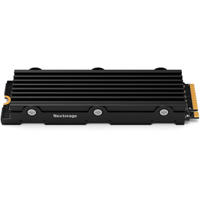Grab either of these 2TB NVMe drives for just $140 and enjoy ultra fast loading times in all your games
They're both ideal SSD upgrades for the PlayStation 5, too.

Solidigm P44 Pro | 2TB | NVMe | PCIe 4.0 | 7,2000 MB/s read | 6,500 MB/s write | $169.99 $139.99 at Newegg (save $30)
Masses of storage. Fast read/write speeds. There's even 2GB of DRAM to help sustain performance. What more do you need from an SSD?
Nextorage NEM-PA| 2TB | NVMe | PCIe 4.0 | 7,300 MB/s read | 6,900 MB/s write | $249.99 $139.99 at Newegg (save $110)
We were very impressed with Nextorage's drive in our review, thanks to its super performance and great thermals. Finding a heatsink-less version is a bit tricky at the moment, so this one won't fit every PC out there.
To heatsink or to not heatsink, that is the question. Okay, that's a silly question, but it's a relevant one in this case. And that's because the Nextorage NEM-PA 2TB is pretty much all the SSD you could ever want. It has very high read and write speeds, and thanks to a large SLC cache and 2GB of onboard DRAM, it can sustain those figures for large data transfers.
So why would you choose the Solidigm P44 Pro 2TB, when its read/write speeds are a little slower and its SLC cache is roughly half the size of the Nextorage? The answer is all to do with where you want to install the SSD.
Gaming motherboards released over the past few years typically sport at least two M.2 slots for NVMe drives and include large metal heatsinks to help prevent the SSDs from hitting any thermal limits and slowing down. While you can use a heatsink-equipped SSD in those slots, you won't be able to use the motherboard's own cooling system.
At best, it'll just spoil the aesthetics of your gaming PC but, at worst, it could also affect the overall storage performance, if those default heatsinks are also used to keep the motherboard chipset cool.
This is where the Solidigm P44 Pro has an advantage over the Nextorage model—it doesn't come with a heatsink already attached to it, making it a piece of cake to add to any motherboard. And if the latter doesn't have its own heatsinks, then you can just go with the Nextorage.
In reality, the performance difference between the two isn't going to be noticeable in games and they both use quality components, so they'll last for years. Solidigm is a brand name of SK Hynix, which makes the NAND flash chips and controller for that SSD. Nextorage was set up by Sony and it uses Micron and Phison for the flash and controller, so again, great parts and a long lifespan.
They're also both certified to work in the PlayStation 5 so if your console is running short on space, slap either of these into the SSD expansion slot and you've immediately got a mountain of space to fill up with new games.
As they're both the same price, you really can't go wrong with choosing either one of them. SSD prices are quite volatile at the moment, so while they have been cheaper than this in the past, as things currently stand $140 for 2TB of blisteringly quick NVMe storage is a great deal.
We're starting to see more games appearing that use DirectStorage, such as Horizon Forbidden West, and this technology makes games load so fast that you'll barely notice any loading screens. Coupled with a fast SSD, you'll easily see what all the fuss is about with the PlayStation 5 and Xbox Series X storage speeds.
Keep up to date with the most important stories and the best deals, as picked by the PC Gamer team.

Nick, gaming, and computers all first met in 1981, with the love affair starting on a Sinclair ZX81 in kit form and a book on ZX Basic. He ended up becoming a physics and IT teacher, but by the late 1990s decided it was time to cut his teeth writing for a long defunct UK tech site. He went on to do the same at Madonion, helping to write the help files for 3DMark and PCMark. After a short stint working at Beyond3D.com, Nick joined Futuremark (MadOnion rebranded) full-time, as editor-in-chief for its gaming and hardware section, YouGamers. After the site shutdown, he became an engineering and computing lecturer for many years, but missed the writing bug. Cue four years at TechSpot.com and over 100 long articles on anything and everything. He freely admits to being far too obsessed with GPUs and open world grindy RPGs, but who isn't these days?



